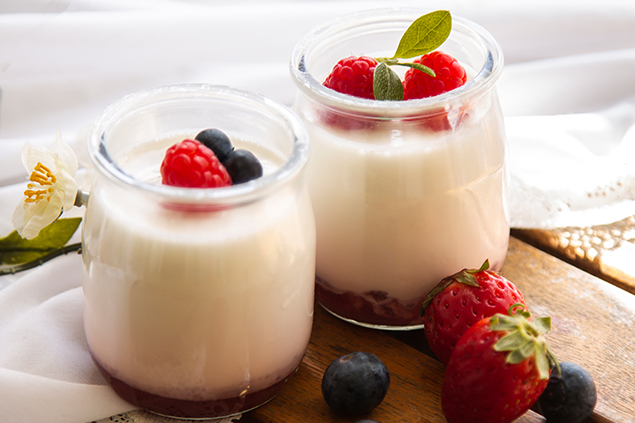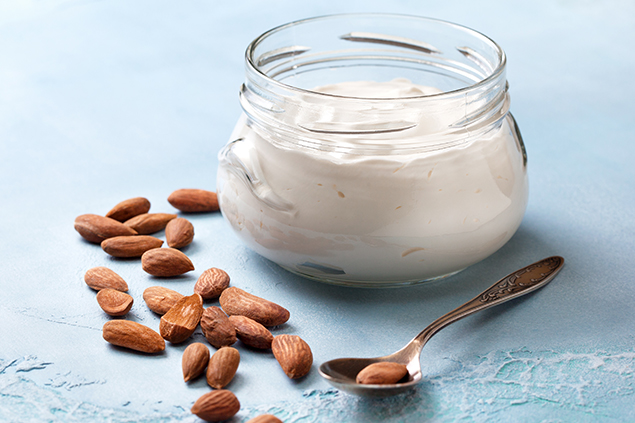Non-dairy yogurts are a growing product category fueled by consumer demand for sustainable, healthy and clean label-friendly options. Vantage Market Research recently reported that the current global non-dairy yogurt market is valued at USD 2.8 billion and is projected to reach a value of USD 7 billion by 2030 at a CAGR of 14.1% between 2023 and 2030.1 Manufacturers can create appealing plant-based yogurts that better mimic the sensory qualities of dairy yogurts.
The rise in non-dairy yogurt in today’s market
Several factors are causing an increase in demand for non-dairy yogurt. Consumer interest in alternative diets, concerns over dairy and lactose intolerance, and increasing awareness of the environmental impact of food production are all part of the equation for the growing interest in non-dairy yogurt.2 Individuals struggling with dairy protein and/or lactose intolerance may opt for non-dairy yogurt, which does not contain milk proteins and/or lactose.
Consumers are also becoming more aware of the effect their purchase choices have on the environment and their health as they look for better ways to indulge. However, they do not want to give up the enjoyment and health benefits of dairy yogurt. Non-dairy yogurt allows consumers to retain their dietary routines without compromising their desire to support their wellness and sustainability goals.
How non-dairy yogurts are produced
Non-dairy yogurt is a fermented food product that uses plant-based ingredients to simulate conventional dairy yogurt's taste, texture and color. A base is mixed with water, vegan lactic acid bacteria cultures and a source of sugar, if there is none present in the base, to initiate fermentation. These microorganisms will slowly convert the sugars into lactic acid, which drives down the pH of the fermentation. The increased acidity causes the proteins in the base to coagulate, increasing the gelling and thickness of the fermenting base.  Photo: ©2024 Getty Images
Photo: ©2024 Getty Images
Overcoming functional challenges
Several challenges arise with manufacturing plant-based yogurts when compared to traditional dairy yogurts. Achieving the desired thickness and consistency to create a pleasant mouthfeel is a must. Emulsification and gelling functional properties are essential for the formulation of non-dairy yogurts with the sensory characteristics consumers expect.
Additionally, some plant-based proteins can add off-flavors and odors or unappealing colors, so finding the right ingredients that achieve the taste and color qualities of dairy yogurts is critical. Almond ingredients have a neutral, clean flavor that makes them highly versatile.
The advantage of almond ingredients for non-dairy yogurts
With a rich combination of protein, fiber, unsaturated fats and minerals, almond butter and almond protein are two plant-based options for creating non-dairy yogurts with great sensory attributes and provide clean label-friendly products. Their neutral taste and functional advantages can also help manufacturers create applications that replicate dairy yogurts' sensory qualities.
How almond butter and almond protein are made
Almond butter is made by roasting almonds and grinding them to a fine paste. The whole almonds are blanched (have their skins removed) before grinding to achieve a smoother texture and lighter color. Almond protein is a high-protein flour produced by grinding blanched whole almonds and mechanically pressing the almond fragments to remove a high percentage of almond oil, producing a compact almond cake. This compact cake is further milled into a fine powder.
The main difference between almond butter and almond protein is the amount of almond oil that is present in each ingredient. Almond oil provides the smooth mouthfeel and creaminess that is typical of traditional dairy yogurts. Almond protein offers the advantage of a low-fat option while retaining the functionality and quality of plant-based proteins.
While almond butter and almond protein have their own advantages, combining both in a non-dairy yogurt formulation creates a well-balanced product. A higher percentage of almond butter combined with a lower percentage of almond protein yields a yogurt with superior appearance, aroma, texture, flavor and aftertaste. For a lower fat option, a lower percentage of almond butter combined with a higher percentage of almond protein produces an equally excellent non-dairy yogurt with higher sensory scores than other plant-based protein ingredients.
Manufacturing benefits
With its uniform, fine particle size, almond protein provides a consistent and smooth texture. This allows the ingredients to be quickly mixed without the need for more intense processing equipment. Almond protein also has excellent gelling properties.
Almond butter has a low viscosity and consistent particle size, making it smoother and easier to pump during production. Almond proteins are easy to disperse and speed output along. The emulsion capacity of almond butter provides a smooth consistency in a food product that does not separate over time.  Photo: ©2024 Getty Images
Photo: ©2024 Getty Images
The almond advantage: nutritional benefits with superior flavor
Almond butter and almond protein are clean label-friendly solutions that provide a nutritional boost with minimum use of additional ingredients. Both provide better-for-you fats, protein, antioxidants and dietary fiber, along with essential minerals and vitamins. They have one of the highest amounts of vitamin E per serving. Almond ingredients are also gluten- and soy-free, which make for more encompassing options for those with food sensitivities. Consumers get the benefit of added nutrition without sacrificing taste or texture.
CJ McClellan, senior manager of strategic marketing for Blue Diamond Global Ingredients, commented on the upward trend of non-dairy yogurts, stating, "As the plant-based category increases in popularity, almond ingredients are a great solution to creating successful non-dairy applications that meet consumer demands and have the functional benefits food manufacturers want."
Partner with Blue Diamond to see how the almond advantage can create plant-based yogurt applications that deliver the sensory experience, nutrition and labels consumers want with the functional benefits you need. Get the full introduction to almond ingredients in plant-based yogurts by downloading our overview here.






